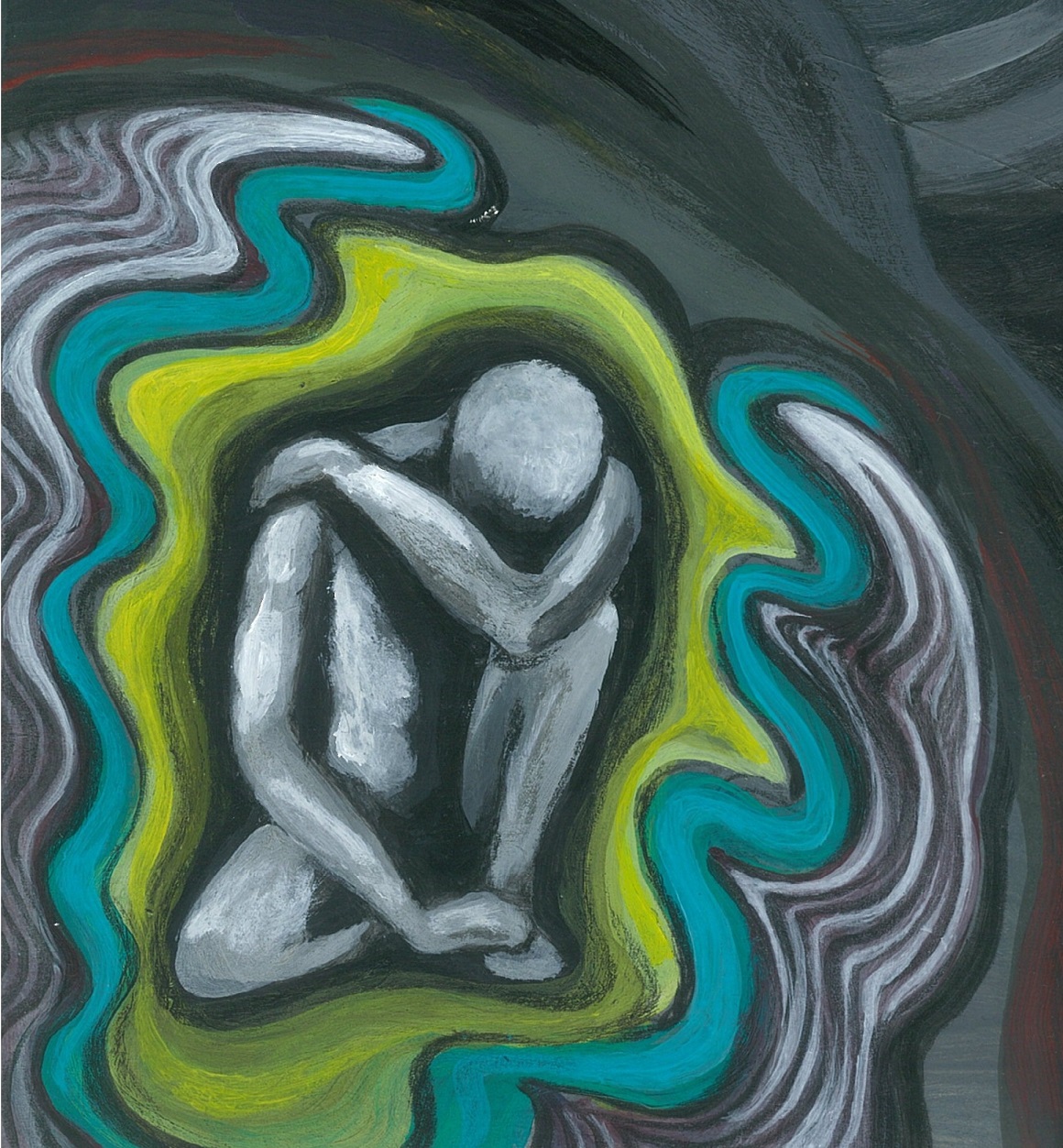
Through further hypnotic inductions and letters written by the alters themselves, the reader comes to understand that Karen’s inner shape-shifting world was based loosely on the layout of her childhood home. Each alter possessed its own space, usually a bedroom, and it appears that these inhabited regions were orientated about a conference room devised for the stringent purpose of communication. In the evening, the family of alters would amalgamate at the conference room, whereupon a short meeting would be held to determine who would undertake diurnal affairs like housework and tending to the children (James and Sara); who would cradle and comfort the wounded vessels; and who would stand sentry over the field of consciousness the following day. Within a protean system whereby each subpersonality was severely handicapped with a particular strain of myopic vision–the desire to escape traumatic pain and repeat avoidance behaviours, the desire for retribution, the desire to improve dissociative functionality, the desire to express creative potential, and so forth–any failure to come to a unanimous agreement would inevitably result in pandemonium.
Perhaps the greatest asset of this problematic, incoherent expression of being was its mutability, its ability to rewire internal hardware according to the specific configuration of circumstances offered up by the immediate holding environment at any one instant. For example, the interactive field facilitating the therapeutic relationship was swiftly integrated into Karen’s inner realm through the establishment of a safe room in which alters could enter one at a time and converse with Baer in private. But there were also psychotherapeutic periods when this intrinsic capacity for inner transformation flirted openly with the abyssal regions of disintegration, inauthenticity, and nonbeing. For instance when Baer decided that facilitating shared recognition of memories and emotions might incur a disintegration of phenomenal barriers separating the hierarchy of false selves, he completely overlooked the epiphenomenon of diffused pain. The false selves of dissociative multiplicity all project from different regions of the psyche, meaning that specific alters hold together the functioning capacities working through the middle unconscious, the numinous qualities of the higher unconscious, and the primal wounding of the lower unconscious. Any forced disintegration of pathological boundaries that hasn’t prepared the system for complete mutuality through a comprehensive exploration of the explicit nature of primal wounding will result in a premature explosion of mental accidents across the entire hierarchy of selves. Suddenly, the alters that maintained a sense of normalcy and order in light of operative archetypal defences become afflicted with the same mental accidents that incapacitate the wounded, creating further confusion and entropy amongst the dissociative synthesis that can, in many instances, incite a fatal plunge into the vortices of self-destruction.
As Baer would soon discover, trying to force these empathic reconnections without plumbing all the wounded layers first is rather futile. On the whole alters are suggestible, one-dimensional, and pathological creations that subscribe to the erroneous logic of an inauthentic, co-dependent, and fragmented self, however it is imperative that each voice be heard before clinical amalgamation is attempted. The extent of their raw power is comprehendible in the manner of their creation, a process dictated by a need to accommodate for unanticipated circumstances. One might compare the whole thing to the laborious subterranean generation of scintillating diamonds from the inert, lacklustre, and abundant mineral carbon contracted into the space of a single second; in order to birth another, the existing alters would form a psychic confluence around Karen’s visceral need and brood on it. As a result, the need would transform into a wish and the wish would sprout into another alter in the manner that a seed might sprout into a perennial tree. In Switching Time Karen stipulates that the first two alters split from the central nuclei of consciousness when she was just a four-month old. If this statement is indeed true, it would be a clinical substantiation for the objective existence of a collective unconscious or group mind.
As we know Karen Overhill’s formative holding environment was abject, nefarious, and offered no external unifying centres that could be appropriated internally for psychospiritual growth and development. An early split remedied this early Gordian knot, producing two omniscient alters that were a year and a half older than Karen Overhill at birth and then aged swiftly to perform the functions of competent parents. Holdon, the first, came equipped with a psychological toolkit of skills, talents, and propensities. He is at once father and son, protector and guardian, the decision-maker, and foremost authority of the hierarchy of selves. He is an Osirian pillar of stability, indestructibility, and eternity; the skeletal backbone and foundation upon which the entire painful synthesis has been wrought. It was he who facilitated communications between the workers and the wounded by constructing a conference room inside Karen’s inner kingdom. It was he who urgently familiarized himself with the psychological and physiological makeup of each and every alter so that system could operate as smoothly as possible. Holdon transcended the stick of underlying agony and pain avoidance that fuelled the rest of the fragmented personality system. Unlike the vast majority whose existence was confined to seething in their own aversions and cravings, Holdon possessed sagacity and psychological aptitude; it was he who wrote to Baer sometime in June or July of 1996 suggesting how the dissociated parts might be integrated. Even more uncanny was the capacity to liberate and supress ideas whenever he so desired. There was nothing static, inauthentic, or mechanistic about him; Holdon had aspirations to be a paramedic, meaning that he could ruminate upon the future and subsequently plot the course of his own development. Such an ability is most symptomatic of I-amness, the retention of a sustained identity through time. What might be made of this then? Karen never flirts with the snake pit of metaphysical speculations regarding the origin of this entity; she never suggests, for instance, that he is some sort of discarnate spirit or guardian angel, although he might as well have been. Katherine, his feminine counterpart, balanced his composure, wisdom, goodwill, and unyielding servitude with creative expression and impeccable administration. She developed eclectic tastes in art and performance music and celebrated this phenomenal link between mathematics and philosophy by learning to play musical instruments like the guitar and the clarinet. Without a doubt, Katherine was the organization powerhouse of the system, ensuring that Karen made and kept to her appointment schedule. She also shared Holdon’s foresight; it was she who prompted Karen to seek professional help. Most fascinating of all is the inherent immunity of these parental alters to pain.
Such a premature splitting of consciousness, one in which internal parental figures separate and evolve autonomously of the host personality, offers a powerful argument in support of Jung’s collective unconscious, the deepest layer of the psyche that receives telepathic impressions of universal and primordial forms, the psychological archetypes. The latter might be described as inherited irrepresentable concepts of numinous and transpersonal nature separate from the sphere of the mental ego but able to garner expression and guide the latter’s formative development once the appropriate environmental stimuli have been activated. Jung stipulated, time and time again, that ideals of mother and father and the altruistic love exuding from them are projections from the collective unconscious. Jung himself described this shared mind as “… not a person, but something like an unceasing stream or perhaps ocean of images and figures which drift into consciousness in our dreams or in abnormal states of mind.”[1] Our psychosynthesis model of human development stipulates that learning occurs through empathic attunement with an external unifying centre which is then interiorized to orientate the unravelling rungs of the personality. For Karen, it has been established that this empathic attunement needed to condition an inner replica of extrinsic values was markedly absent in her formative years. There is simply no way that she could comprehend and identify with a responsible, loving parent and objectify qualities associated with them if she had never experienced such qualities before. You cannot produce from within yourself what you have not experienced, or can you? If the latter were true then the earliest alters originating from the central nuclei of consciousness should not express altruistic love, service, trust, faith, compassion, courage, cooperation, and any profound expression of the higher unconscious. But the narrative says that they did. In fact, both Holdon and Katherine augmented their development in order to express these qualities in an authentic manner, as internal parents to Karen Overhill. The only viable answer to this riddle is that the fount of universal potential called the collective unconscious was tapped early, allowing telepathic communication of archetypal images and figures that would become these alters to project into multiple nuclei of consciousness or ‘abnormal states of mind’ and develop prematurely for survival purposes. There may very well be a ‘shared’ mind.









